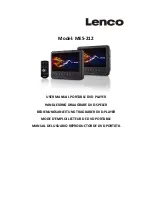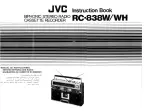
— 2 —
TABLE OF CONTENTS
1. SERVICE NOTES
···························································· 3
2. GENERAL
·········································································· 4
3. DISASSEMBLY
3-1.
Front Cabinet Assy ····························································· 5
3-2.
Control-1, Head Phone Board ············································ 6
3-3.
Cabinet (Upper) Assy ························································· 6
3-4.
Power, Batt, Tuner, Batt Com Board ·································· 7
3-5.
Main, Line In, LCD Board ················································· 7
3-6.
CD Board, Optical Pick-up Section,
Mechanism Deck ································································ 8
4. ADJUSTMENT
4-1.
Mechanical Adjustment ······················································ 9
4-2.
Electrical Adjustment ························································· 9
5. DIAGRAM
5-1.
Circuit Boards Location ··················································· 12
5-2.
Block Diagrams – Tuner Section – ··································· 13
– Main Section – ······························································· 15
5-3.
Schematic Diagram – CD Section – ································· 18
5-4.
Printed Wiring Board – CD Section – ······························ 21
5-5.
Schematic Diagram – Cassette Deck Section – ················ 23
5-6.
Printed Wiring Board – Cassette Deck Section – ············· 25
5-7.
Schematic Diagram – Tuner Section – ····························· 27
5-8.
Printed Wiring Board – Tuner Section – ·························· 29
5-9.
Printed Wiring Board – Main Section – ··························· 31
5-10. Schematic Diagram – Main Section (1/2) – ····················· 33
5-11. Schematic Diagram – Main Section (2/2) – ····················· 35
5-12. Printed Wiring Board and Schematic Diagram
– Control Section – ·························································· 37
5-13. Schematic Diagram – Power Section – ···························· 39
5-14. Printed Wiring Board – Power Section – ························· 41
5-15. IC Pin Function Description ············································· 43
5-16. IC Block Diagrams ··························································· 45
6. EXPLODED VIEWS
6-1.
Front Cabinet Section ······················································· 49
6-2.
Rear Cabinet Section ························································ 50
6-3.
Upper Cabinet Section ······················································ 51
6-4.
Mechanism Deck Section (1) (MF-V10-117) ·················· 52
6-5.
Mechanism Deck Section (2) (MF-V10-117) ·················· 53
6-6.
Optica Pick-up Section (KSM-213CDM) ························ 54
7. ELECTRICAL PARTS LIST
···································
55
SAFETY-RELATED COMPONENT WARNING!!
COMPONENTS IDENTIFIED BY MARK
!
OR DOTTED LINE WITH
MARK
!
ON THE SCHEMATIC DIAGRAMS AND IN THE PARTS
LIST ARE CRITICAL TO SAFE OPERATION. REPLACE THESE
COMPONENTS WITH SONY PARTS WHOSE PART NUMBERS
APPEAR AS SHOWN IN THIS MANUAL OR IN SUPPLEMENTS
PUBLISHED BY SONY.
ATTENTION AU COMPOSANT AYANT RAPPORT
À LA SÉCURITÉ!
LES COMPOSANTS IDENTIFÉS PAR UNE MARQUE
!
SUR LES
DIAGRAMMES SCHÉMATIQUES ET LA LISTE DES PIÈCES SONT
CRITIQUES POUR LA SÉCURITÉ DE FONCTIONNEMENT. NE
REMPLACER CES COMPOSANTS QUE PAR DES PIÈSES SONY
DONT LES NUMÉROS SONT DONNÉS DANS CE MANUEL OU
DANS LES SUPPÉMENTS PUBLIÉS PAR SONY.
After correcting the original service problem, perform the following
safety checks before releasing the set to the customer:
Check the antenna terminals, metal trim, “metallized” knobs, screws,
and all other exposed metal parts for AC leakage. Check leakage as
described below.
LEAKAGE
The AC leakage from any exposed metal part to earth ground and
from all exposed metal parts to any exposed metal part having a
return to chassis, must not exceed 0.5 mA (500 microamperes).
Leakage current can be measured by any one of three methods.
1.
A commercial leakage tester, such as the Simpson 229 or RCA
WT-540A. Follow the manufacturers’ instructions to use these
instruments.
2.
A battery-operated AC milliammeter. The Data Precision 245
digital multimeter is suitable for this job.
3.
Measuring the voltage drop across a resistor by means of a
VOM or battery-operated AC voltmeter. The “limit” indication
is 0.75 V, so analog meters must have an accurate low-voltage
scale. The Simpson 250 and Sanwa SH-63Trd are examples of
a passive VOM that is suitable. Nearly all battery operated
digital multimeters that have a 2V AC range are suitable. (See
Fig. A)
SAFETY CHECK-OUT
To Exposed Metal
Parts on Set
0.15
µ
F
1.5 k
Ω
AC
Voltmeter
(0.75 V)
Earth Ground
Fig. A. Using an AC voltmeter to check AC leakage.



































